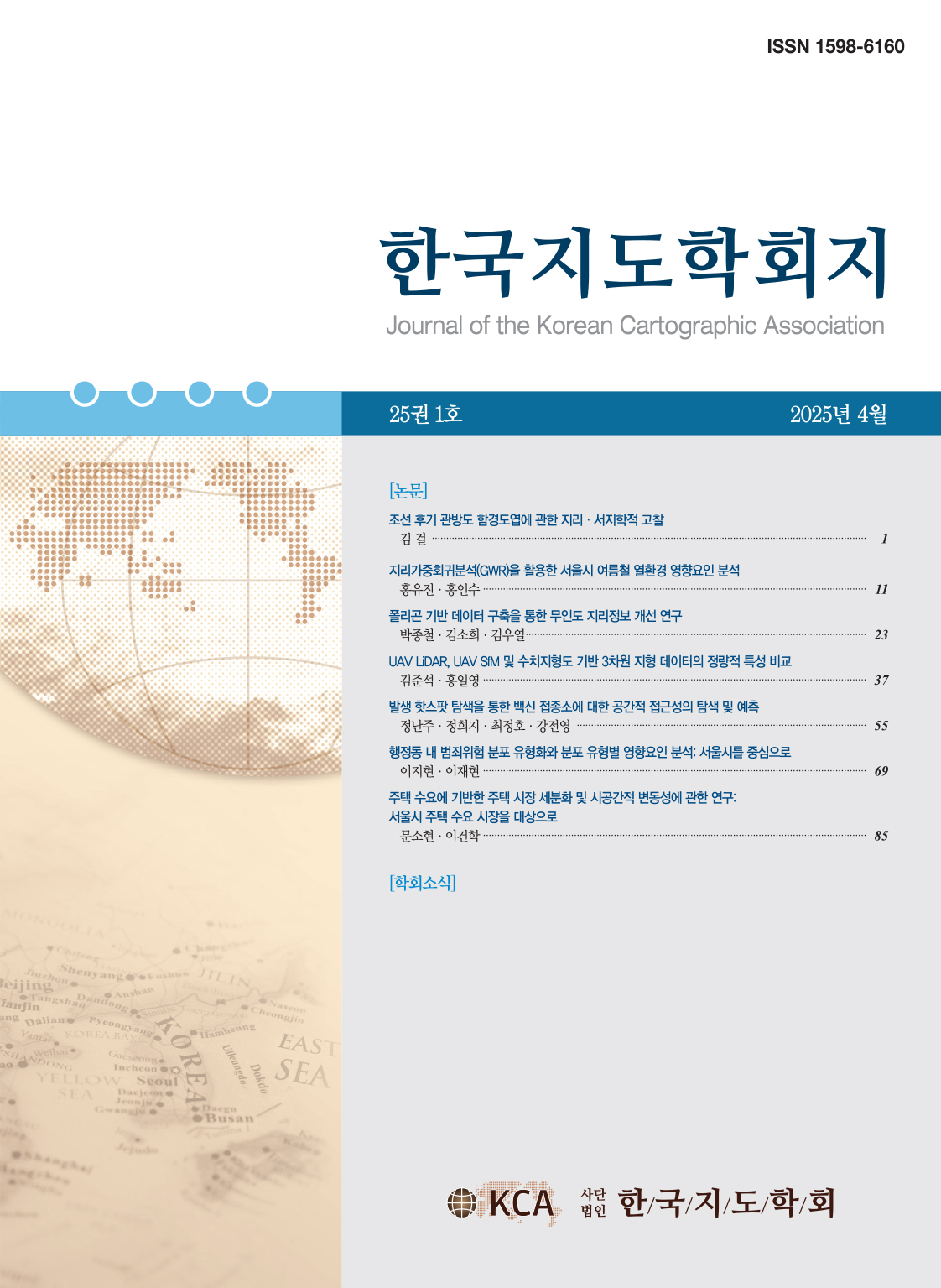Research Article
Abstract
References
Information
As elderly population is increasing, the quality of their life and ‘active aging’ or ‘age-friendly cities’ for healthy and active retirement for the elderly have been paid more attention. In this situation, many local governments attempt to provide various senior leisure welfare services to enjoy the rest of life in a local community. However, those services are not supplied properly in terms of the actual demand of elderly population, and there exists a spatial disparity of the provision of senior leisure welfare services. This is because there is no legal guideline on the spatial location of senior leisure welfare facilities. In this regard, this study explores a spatial mismatch between the demand and supply for senior leisure welfare facilities in Seoul, and suggests optimal locations for the senior welfare center by considering spatial efficiency and spatial equity. As a result, we presented various optimal solutions based on several location scenarios to enhance the spatial accessibility of the senior welfare center in Seoul. Also, our results can be utilized as useful materials for planning or policy-making for the future provision of elderly welfare services.
최근 노인 인구가 증가함에 따라, 이들의 삶의 질에 대한 사회적 관심도가 높아지고 있으며, 노인들의 건강하고 활기찬 노후를 고려하는 활동적 노후 및 고령친화도시의 개념이 주목받고 있다. 이러한 상황에서 많은 지자체는 노인들이 지역 사회에서 여생을 의미 있게 보낼 수 있도록 다양한 노인여가복지 서비스를 제공하기 위해 노력하고 있다. 그러나 실질적인 노인 수요에 부합하는 서비스 공급이 이루어지지 못하고 있으며, 지역별로 노인여가복지 서비스의 공간적 격차가 발생하고 있는 실정이다. 이는 노인여가복지 입지와 관련하여 체계적인 법적 기준이 부재하기 때문이다. 이에 본 연구는 서울시의 노인여가복지 시설에 대한 수요와 공급의 공간적 불일치성을 탐색하고, 공간 효율성과 형평성을 고려한 노인복지센터의 최적 입지 대안을 제시하고 있다. 연구 결과, 여러 입지 시나리오에 따라 서울시 노인복지센터의 공간적 접근성을 향상시킬 수 있는 다양한 최적 입지 대안들을 제시할 수 있었으며, 향후 노인복지 서비스 공급과 관련한 계획 및 정책에 있어 중요한 기초 자료로 활용될 수 있을 것으로 기대된다.
- 권영길, 2006, “노인복지관 프로그램 만족도의 결정요인에 관한 연구: 수도권 지역을 중심으로,” 노인복지연구, 33, 103-126.
- 권중돈, 2016, 「노인복지론」, 서울: 학지사.
- 김금환・김윤재, 2013, “DEA 모형을 이용한 노인복지관의지역별 효율성 분석,” 노인복지연구, 60, 55-76. 10.21194/kjgsw..60.201306.55
- 김동균, 2016, GIS를 활용한 서울의 보편적 복지시설 입지의 지역편차 및 복지서비스권역분석, 서울시립대학교 석사학위논문.
- 김욱진・김태연, 2022, “서울시 사회복지관 신규 건립을 위한 입지 연구 - 서비스권역과 입지할당의 GIS 네트워크 분석을 중심으로 -,” 한국사회복지학, 74(1), 53-78. 10.20970/kasw.2022.74.1.003
- 김종근, 2013, “지역포괄 시설물 입지선정 문제를 위한 라그란지안 해법 연구,” 한국지도학회지, 13(1), 143-153.
- 마세인・김흥순, 2011, “GIS 네트워크 분석을 활용한 노인복지시설의 접근성 연구: 인천시 내륙부를 중심으로,” 국토연구, 70, 61-75. 10.15793/kspr.2011.70..004
- 소준영, 2006, “서울시 노인종합복지관의 유형별 공간특성에 관한 연구,” 한국실내디자인학회 논문집, 15(5), 209-220.
- 손승호・한문희, 2010, “고령화의 지역적 전개와 노인주거복지시설의 입지,” 한국도시지리학회지, 13(1), 17-29. 10.17960/ell.2011.17.2.002
- 손정렬・오수경, 2007, “GIS 공간분석기법을 이용한 서울시 노인주간보호시설의 접근성 연구,” 한국지역지리학회지, 13(5), 576-594.
- 송준민・정재용, 2013, “노인복지시설의 입지적 특성에 관한 연구 - 서울시 노인복지관을 중심으로,” 대한건축학회연합논문집, 15(6), 63-72.
- 신혜종, 2008, “소도시 노인종합복지관 이용에 영향을 미치는 요인에 관한 연구,” 한국지역사회복지학, 25, 201-221.
- 안재성・김이배・박미라, 2014, “2SFCA 기반 공간적 접근성의 변화 특성에 관한 연구 : 구미시 노인복지시설을 중심으로,” 한국지리정보학회지, 17(4), 112-128. 10.11108/kagis.2014.17.4.112
- 양재섭・성수연, 2022, 「서울시 고령인구 밀집지역의 사회 공간적 특성과 근린환경 개선방향」, 서울연구원.
- 원보람, 2006, 노인인구구조 특성에 노인인구구조 특성에 따른 서울시 재가노인복지시설의 공급과 재가노인복지시설의 공급과 입지에 관한 연구, 서울시립대학교 석사학위논문.
- 원영희・모선희, 1998, “노인복지관에 관한 연구: 현황과 발전방안,” 한국노년학, 18(2), 64-79.
- 윤민석・문진영, 2018, 「노인인구 증가로 사회서비스시설 확충 시 활동지역・생활인구 고려한 수요분석 필요」, 서울연구원.
- 이건학, 2010, “동통폐합에 따른 동주민센터의 입지 변화 분석과 최적 입지 모델링-공간적 효율성 및 형평성 접근,” 대한지리학회지, 45(4), 521-539.
- 이건학, 2012, “와이파이 기반 U-캠퍼스 구축을 위한 커버리지 분석과 최적 입지 모델링,” 한국지도학회지, 12(2), 47-58.
- 이건학, 2015, “광역 커버리지 슈퍼 와이파이 최적 입지 모델링,” 한국지도학회지, 15(1), 37-58. 10.16879/jkca.2015.15.1.037
- 이건학・김감영, 2013, “화이트 스페이스를 활용한 슈퍼 와이파이 시설의 효율적 배치를 위한 공간 입지 모델링,” 대한지리학회지, 48(2), 259-271.
- 이영아・진영환, 2001, “노인을 위한 도시환경조성에 관한 연구,” 국토연구, 32, 77-93.
- 이윤경・정경희・오영희・염주희・김향아, 2012, 「노인여가복지서비스 발전방안 연구」, 한국보건사회연구원.
- 임영희・주창범, 2021, “소규모 노인복지센터의 효율적 운영 방안에 관한 연구: 일본의 노인복지센터, 지역포괄지원센터와 비교연구,” 사회과학연구, 28(1), 130-156. 10.46415/jss.2021.03.28.1.130
- 정순둘・선한나・김고은, 2011, “노인복지관 운영 및 프로그램 분석과 발전방향,” 한국사회복지행정학, 13(3), 179-199. 10.22944/kswa.2011.13.3.007
- 정은하・박지선・유은경・임승연, 2018, 「초고령사회 대응을 위한 서울형 노인복지시설 구축 방안 연구」, 서울시복지재단.
- 조성아・이건학, 2017, “공간 통계를 활용한 서울시 노년 인구 거주지와 노인 수요 시설 분포의 공간적 불일치 탐색,” 한국도시지리학회지, 20(2), 99-112. 10.21189/JKUGS.20.2.8
- 홍지수・문지석, 2023, “GIS 네트워크 분석을 통한 서울시 노인복지시설 공급 및 입지 특성 연구: 보행 접근성과 시설 차량 접근성을 중심으로,” 도시연구, 23, 317-365. doi.org/10.34165/urbanr.2023..23.317
- 황남희, 2014, “한국 노년층의 여가활동 유형화 및 영향요인 분석,” 보건사회연구, 34(2), 37-69. 10.15709/hswr.2014.34.2.37
- Anselin, L., 1995, Local indicators of spatial association-LISA, Geographical Analysis, 27(2), 93-115. 10.1111/j.1538-4632.1995.tb00338.x
- Anselin, L., Syabri, I., and Smirnov, O., 2002, Visualizing multivariate spatial correlation with dynamically linked windows, Proceedings, In New Tools for Spatial Data Analysis, Specialist Meeting, University of California, Santa Barbara.
- Cheng, M. and Cui, X., 2020, Spatial optimization of residential care facility configuration based on the integration of modified immune algorithm and GIS: A case study of Jing’an district in Shanghai, China, International Journal of Environmental Research and Public Health, 17(21), 8090. 10.3390/ijerph1721809033153047PMC7662911
- Friedlander, W.A. and Apte, R.Z., 1980, Introduction to social welfare, 5th ed., New Jersey: Prentice-Hall.
- Hakimi, S.L., 1964, Optimum locations of switching centers and the absolute centers and medians of a graph, Operation Research, 12(3), 450-459. 10.1287/opre.12.3.450
- Halpern, J., 1976, The location of a center‐median convex combination on an undirected tree, Journal of Regional Science, 16(2), 237-245. 10.1111/j.1467-9787.1976.tb00966.x
- Huang, X., Gong, P., and White, M., 2022, Study on Spatial distribution equilibrium of elderly care facilities in downtown Shanghai, International Journal of Environmental Research and Public Health, 19(13), 7929. 10.3390/ijerph1913792935805586PMC9266222
- Kitajima, T., Kitazawa, T., Cho, K.I., and Noyama, O., 2001, “地理情報システムを用いた通所介護施設への地域高齢者の地理的アクセス推計の試み,” 日本公衆衛生雑誌, 48(8), 613-619. (in Japanese)
- Love, D. and Lindquist, P., 1995, The geographical accessibility of hospitals to the aged: a geographic information systems analysis within Illinois, Health Services Research, 29(6), 629-651.
- Moran, P., 1950, Notes on continuous stochastic phenomena, Biometrika, 37(1/2), 17-23. 10.2307/233214215420245
- Rantakokko, M., Mänty, M., and Rantanen, T., 2013, Mobility decline in old age, Exercise and Sport Sciences Reviews, 41(1), 19-25. 10.1097/JES.0b013e3182556f1e23038241
- Takahashi, M., Odagiri, Y., and Uchida, H., 2006, “地理情報システム(GIS)を使用した介護サービス施設の配置に関する検討: 甲府市の通所介護施設を事例として,” 山梨県立大学看護学部紀要, 8, 1-8. (in Japanese)
- Takahashi, K. and Ogihara, A., 2009, Visualization of the relationship between the geographic distribution of day service facilities for the elderly and local elderly residents using a geographic information system, Bulletin of Social Medicine, 26(2), 1-12.
- 국토교통부, 2018, 국가도시재생 기본방침.
- 경산시 노인종합복지관, 2023, http://gsswc.org/
- Publisher :The Korean Cartographic Association
- Publisher(Ko) :한국지도학회
- Journal Title :Journal of the Korean Cartographic Association
- Journal Title(Ko) :한국지도학회지
- Volume : 23
- No :3
- Pages :33-53
- DOI :https://doi.org/10.16879/jkca.2023.23.3.033



 Journal of the Korean Cartographic Association
Journal of the Korean Cartographic Association





